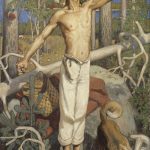
Akseli Gallen-Kallela was born Axel Waldemar Gallén in Pori, Finland in a Swedish-speaking family. His father Peter Gallén worked as police chief and lawyer. Gallen-Kallela was raised in Tyrvää.[ At the age of 11 he was sent to Helsinki to study at a grammar school, because his father opposed his ambition to become a painter. After his father’s death in 1879, Gallen-Kallela attended drawing classes at the Finnish Art Society (1881-4) and studied privately under Adolf von Becker.
In 1884 he moved to Paris, to study at the Académie Julian.[ In Paris he became friends with the Finnish painter Albert Edelfelt, the Norwegian painter Carl Dörnberger, and the Swedish writer August Strindberg.
He married Mary Slöör in 1890. The couple had three children, Impi Marjatta, Kirsti and Jorma. On their honeymoon to East Karelia, Gallen-Kallela started collecting material for his depictions of the Kalevala. This period is characterized by romantic paintings of the Kalevala, like the Aino Myth, and by several landscape paintings.[
In December 1894, Gallen-Kallela moved to Berlin to oversee the joint exhibition of his works with the works of Norwegian painter Edvard Munch. Here he became acquainted with the Symbolists.
Sad Turning Point
In March 1895, he received a telegram that his daughter Impi Marjatta had died from diphtheria. This would prove to be a turning point in his work. While his works had previously been romantic, after his daughter’s death Gallen-Kallela painted more aggressive works like the Defense of the Sampo, Joukahainen’s Revenge, Kullervo Cursing and Lemminkäinen’s Mother.
On his return from Germany, Gallen studied print-making and visited London to deepen his knowledge, and in 1898 studied fresco-painting in Italy. Source: Wikipedia.






